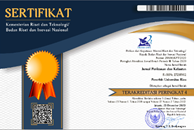Utilization of Fermented Chicken Feather Flour Using Rhizopus sp in Feed on the Growth of Striped Catfish (Pangasianodon hypophthalmus)
(1) Department of Aquaculture, Faculty of Fisheries and Marine, Universitas Riau
(2) Department of Aquaculture, Faculty of Fisheries and Marine, Universitas Riau
(3) Department of Aquaculture, Faculty of Fisheries and Marine, Universitas Riau
(*) Corresponding Author
Abstract
Keywords
Full Text:
PDFReferences
[NRC] National Research Council. (1993). Nutrient requirements of fish. Subcommittee on Fish Nutrition, National Research Council. National Academic Press (USA). 124pp.
Achmad, W. (2001). Potensi limbah agroindustri sebagai pakan sapi perah. Fakultas Peternakan. Institut Pertanian Bogor. Bogor. 67 p.
Adelina, A., Feliatra, F., Siregar, Y.I., Putra, I., Suharman. I. (2021). Use of chicken feather meal fermented with Bacillus subtilis in diets to increase the digestive enzyme activity and nutrient digestibility of silver pompano Trachinotus blochii (Lacepade, 1801). F1000 Research; 1-17.
Adelina, A., Feliatra, F., Siregar, Y.I., Suharman, I. (2020). Utilization of feather meal fermented Bacillus subtillis to replace fish meal in diet to increase the digestive enzymes activity and nutrient digestibility of silver pompano, Trachinotus blochii (Lacepede, 1801). AACL Bioflux, 13(1): 100-18.
Andriani, Y., Setiawati, M., Mas, T.D.J. (2018). Kecernaan pakan dan kinerja pertumbuhan yuwana ikan gurami, Osphronemus goramy Lacepade, 1801 yang diberi pakan dengan penambahan glutamin. Jurnal Ikhtiologi Indonesia, 19(1): 1-11.
Craig, S., Helfrich, L.A. (2002). Understanding fish nutrition, feeds, and feeding. Cooperative Extension Service Publication. Virginia State University, USA.
Dani, N.P., Budiharjo, A., Listyawati, S. (2005). Komposisi pakan buatan untuk meningkatkan pertumbuhan dan kandungan protein ikan tawes (Puntius javanicus Blkr). J. BioSMART, 7(2): 83-90.
Gunadi, B., Febrianti R., Lamanto. (2010). Keragaman Kecernaan pakan tenggelam dan terapung untuk ikan lele dumbo (Clarias gariepinus) dengan dan tanpa aerasi. Prosiding Forum Inovasi Teknologi Akuakultur. 7 p.
Haetami, K., Sukaya, S. (2005). Evaluasi kecernaan tepung azola dalam ransum ikan bawal air tawar (Colossoma macocomum Cuvier 1818). Jurnal Bionatura, 7(3): 225-233.
Hanafiah, A.K. (2005). Rancangan percobaan. PT. Raja Grafindo Persada. Jakarta. 150 p.
Joshi, S.G., Tejashwini, M.M., Revati, N., Sridevi, R., Roma, D. (2007). Isolation, identification, and characterization of feather degrading bacterium. Department of Biotechnology. New Delhi.
Kurniasih, T., Indira, F., Irma, M., Zafril, I.A. (2012). Pemberian ekstrak enzim kasar dari cairan rumen domba pada tepung bungkil kedelai lokal dan pengaruhnya terhadap pertumbuhan ikan nila. Jurnal Riset Akuakultur, 7 (2): 247-256.
Leo, B., Raharjo, E.I., Farida, F. (2014). Kombinasi pelet dan cacing tanah (Lumbricus rubellus) terhadap pertumbuhan dan kelangsungan hidup ikan ringau (Datnioides mescrolepis). Fakultas Perikanan dan Ilmu Kelautan. Universitas Muhammadiyah Pontianak.
Lestari, S. (2001). Pengaruh kadar ampas tahu yang difermentasi terhadap efisiensi pakan dan pertumbuhan ikan mas (Cyprinus carpio). Fakultas Perikanan dan Ilmu Kelautan. Institut Pertanian Bogor. 46 p.
Lopez-Otin, C., Bond, J.S. (2008). Proteases: Multifunctional enzymes in life and disease. J Biol Chem. 283:30433-30437.
Mulyani, Y.S. (2014). Pertumbuhan dan efisiensi pakan ikan nila yang dipuasakan secara periodik. Jurnal Akuakultur Rawa Indonesia. 9(1): 1-12.
Muslim, M.P., Hotly, H., Widjajanti, H. (2009). Penggunaan ekstrak bawang putih (Allium sativum) untuk mengobati benih ikan patin siam (Pangasius hypophthalmus) yang diinfeksi bakteri Aeromonas hydrophylla. Jurnal Akuakultur Indonesia, 8(1): 91-100.
Panjaitan, C., Adelina, A., Suharman, I. (2017). The utilization of fermented feather meal using Bacillus sp. from tiger shrimp (Penaeus monodon) for fish feed of barramundi (Lates calcarifer, Bloch) fingerling. JOM Fakultas Perikanan dan Kelautan Unviersitas Riau13 p.
Papadopoulus, M.C., Boushy, A.R., Kateinar, BH. (1985). Effect of different processing conditions of amino acid digestibility of feather meal determined by chicken Assay. Poultry Sci., 64: 1729-1741.
Pohlenz, C., Buentello, A., Bakke, A.M., Gatlin, D.M. (2012). Free dietary glutamine improves intestinal morphology and increases enterocyte migration rates but has limited effects on plasma amino acid profile and growth performance of channel catfish Ictalurus punctatus. Aquaculture, 370-371: 32-39.
Sari, I.P., Yulisman, Y., Muslim, M. (2017). Laju pertumbuhan dan efisiensi pakan ikan nila (Oreochromis niloticus) yang dipelihara dalam kolam terpal yang dipuasakan secara periodik. Jurnal Akuakultur Rawa Indonesia, 5(1): 45-55.
Sinoy, T.C.P. Bhausaheb, B., Rajendra, P.P. (2011). Isolation and identification of feather degradable microorganisms. VSRD Technical & Non-Technical Journal, 2(3): 128-136.
Soedibya, P.H.T. (1999). Variasi fisiologis ikan gurami (Osphronemus gouramy Lac.) dalam menghadapi ketersediaan sumber pakan. Program Pascasarjana. Bogor: Institut Pertanian Bogor.
Sun, H.J., Lee, H.K. (2001). Characterization of a keratinolytic serine protease from Bacillus subtilis KS-1. Journal of Protein Chemistry, 20:165-169.
Suryanti, S., Syarief, R., Irianto, H.E., Sukarno, S. (2011). Pengaruh Pencucian terhadap sifat fungsional daging lumut ikan patin siam (Pangasius hypophthalmus). Jurnal Pascapanen dan Bioteknologi Kelautan dan Perikanan, 6: 111-117.
Suwarsito, S., Anggoro, S. (2005). Pemanfaatan ampas tahu dengan metode fermentasi untuk bahan baku ikan lele. Laporan Penelitian. Universitas Muhammadiyah Purwokerto. Purwokerto.
Watanabe, T. (1988). Fish nutrition and mariculture. Department of Aquatic Bioscience. Tokyo University of Fisheries. JICA. 223 p.m.
Zonneveld, N., Huisman, E.A., Boon J.H. (1991). Prinsip-prinsip budidaya ikan. PT Gramedia Pustaka Utama. Jakarta. 318 p.
Article Metrics
Abstract view : 70 timesPDF - 45 times
DOI: http://dx.doi.org/10.31258/jpk.29.1.77-85
Copyright (c) 2024 Muhammad Ahlun Nazar, Adelina, Indra Suharman

This work is licensed under a Creative Commons Attribution-NonCommercial-NoDerivatives 4.0 International License.
Gedung Marine Center Lt 2. Fakultas Perikanan dan Kelautan Universitas Riau



